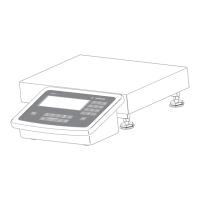53
With the Checkweighing application, you
can check whether the sample on the
weighing platform matches a target
value, or lies within a given tolerance
range. Checkweighing also makes it easy
to fill sample materials to specified target
weight.
Features
– Enter the nominal or target weight
(setpoint) and the tolerance range delim-
iters either using the keypad or
by saving the weight value from
a load on the platform.
– Enter the tolerance limits as absolute val-
ues (Min and Max) or as percentages of
the target. Configuration:
Appl O: 4.5.
– The target value can be taken over
as a weighed value from a weighing plat-
form, and the tolerance limits are defined
by the percentage of deviation from the
target value (menu code 4.5.2). The fol-
lowing percentages can be selected as the
deviation: 0.1%, 0.2%, 0.5%, 1%, 1.5%,
2%, 3%, 5% or 10%.
– The target value, lower tolerance limit
(minimum) and upper tolerance limit
(maximum) can be taken over as weighed
values from the weighing
platform.
– Target and tolerance limits checked dur-
ing input; values must conform to: Upper
limit > Target > Lower limit >
1 digit.
– Checkweighing range: either 30%
to 170% of the target, or from 10%
to infinity.
– Results are shown on the main display
and the bar graph and sent to control
output ports for further processing.
– Toggle the main display between weight
and tolerances limits by pressing w. If
the weight on the readout is outside the
tolerance range, “
LL" (too low) or “HH"
(too high) is displayed.
– Activate info mode by pressing I
– Automatic printout of results.
Configuration:
Appl O: 4.6.
– Automatic taring of container weight.
Configuration:
Appl O: 3.7.
– Automatic initialization with the
most recently saved application data
when you switch on the Midrics.
Configuration:
Appl O: 3.8.
– Closing application program;
deleting parameters:
The value for reference sample weight
remains active in the reference memory
until you delete it by pressing the
c key, overwrite it or until you select a
different application.
– Restore factory default settings.
Configuration:
Appl O: 9.1.
Checkweighing entails comparing
the current weight value to a defined tar-
get. You can enter the value for this tar-
get using the keypad, or by saving the
weight value displayed.
You can also define upper and lower tol-
erance limits based on this target. You
can do this by:
– Entering absolute values using the
keypad or placing the desired amount of
weight on the platform and saving the
value, or
– Entering each value as a percentage
of the target weight
The initial application values are valid
until deleted by pressing the c key or
until overwritten by new values. They
also remain saved after you switch off
the scale.
– Tare function:
1) If you store a tare (weight value)
by pressing the ) key, you can later
enter a tare value manually. The tare
value you enter is added to the stored
tare value.
Setting: menu code 3.25.1
(factory default)
2) A tare value entered manually
overwrites a stored tare value (weight
value). If you enter a tare value manually,
a tare value (weights value) stored later
overwrites the manually entered value.
Setting: menu code 3.25.2
Operating menu setting:
Appl O: 3.25.
Preparation
§ Switch on the scale: Press e
§ While all segments are lit,
press the ) key
§ Select the Application menu: Press k
repeatedly until
APPL is displayed
§ Open the Application menu:
Press the ) key
§ Select the Checkweighing application:
Press the k key repeatedly until
the desired menu item is displayed and
press ) to open the submenu
Application Parameters: Checkweighing
3.5. Minimum load for automatic taring
and automatic printing
3.5.1* 1 digit
3.5.2 2 digits
3.5.3 5 digits
3.5.4 10 digits
3.5.5 20 digits
3.5.6 50 digits
3.5.7 100 digits
3.5.8 200 digits
3.5.9 500 digits
3.5.10 1000 digits
3.7. Automatic taring: first weight tared
3.7. 1* Off
3.7.2 On
3.8. Start application and load most
recent application data when the
Midrics is switched on
3.8.1 Automatic (on)
3.8.2* Manual (off)
3.25. Tare function
3.25.1* Add input value
(weight value) for taring
3.25.2 Tare value can be
overwritten
4.2. Checkweighing range
4.2.1* 30% to 170%
4.2.2 10% to infinity
4.3. Activate control line for “Set" as:
4.3.1* “Set" output
4.3.2 Ready to operate
4.4. Activation of outputs
4.4.1 Off
4.4.2 Always active
4.4.3 Active at stability
4.4.4* Active within check range
4.4.5 Active at stability within
the check range
4.5. Parameter input
4.5.1* Min, max, target
4.5.2 Only target with
percent limits
4.6. Automatic printing
4.6.1* Off
4.6.2 On
4.6.3 Only values within
tolerance
4.6.4 Only values outside
tolerance
4.7. Checkweighing toward zero
4.7.1* Off
4.7.2 On
* = Factory setting
§ Press ) to save your settings and (
(repeatedly) to exit the operating menu.
Application: Checkweighing O

